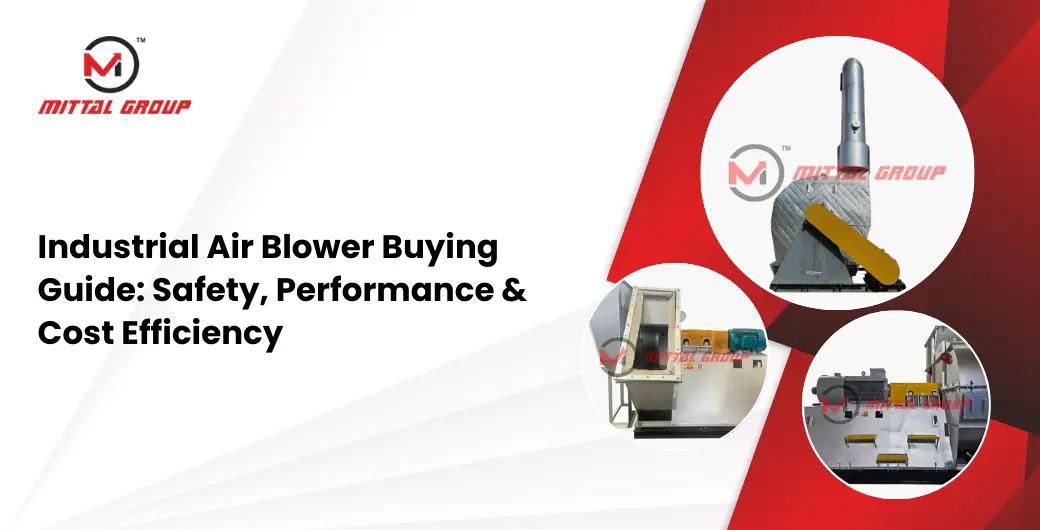Industrial Air Blower Buying Guide: Safety, Performance & Cost Efficiency

In today’s industries, airflow and ventilation are essential to ensure operations are running smoothly. From cooling equipment to dust collection, material handling, or HVAC, an industrial air blower is indispensable in guaranteeing efficiency and safety. The selection of a proper blower is not merely choosing a device that displaces air, it’s about investing in performance, reliability, and long-term cost benefits. Dealing with a reliable industrial air blower manufacturer will ensure you receive an appropriately designed system to suit your industrial needs.
Key Considerations When Buying an Industrial Air Blower
Choosing the best industrial air blower involves a delicate trade-off for safety, functionality, and cost effectiveness. Knowing the factors that affect blower performance and maintenance can be money- and time-saving for companies.
- Air Blower Type
There are several types of industrial air blowers, including centrifugal blowers, axial fans, and positive displacement blowers. Each has a particular application:
Centrifugal blowers: Suitable for high-pressure uses such as dust collection, material handling, and industrial ventilation systems.
Axial fans: Most suitable for open-space ventilation and cooling, offering a high airflow volume at reduced pressures.
Positive displacement blowers: Employed in applications that need constant air volume at fluctuating pressures.
Selecting the correct one allows your blower to satisfy working needs without straining the system.
- Performance and Efficiency
Performance measures like air volume flow, pressure, and power intake are vital. High performance blowers are constructed to deliver high productivity and perform demanding industrial activities. Contemporary blowers also have variable speed capabilities, and this enables easy control of air flow, which may enhance productivity as a whole. Utilizing a power saving air blower saves money on operations and is good for environmentally friendly practices.
- Safety Issues
Industrial air blowers have to be in accordance with safety standards and air blower safety specifications. Be on the lookout for overload protection, vibration dampening, and rugged build to avoid accidents and equipment damage. Proper installation and regular maintenance are also important to provide long-term safety.
- Material and Build Quality
Construction material of blowers impacts longer service lifespan and performance. Rust-proof high quality materials or stainless steel is used in applications where there is the presence of moisture, chemicals, or abrasive particles. Properly engineered blower machines design reduces wear and tear, reduces maintenance expenses, and extends the service life of the blower.
- Noise Levels
Noise might be a serious issue in factories. Using a blower that is low-noise produces workplace safety and comfort. Certain devices have soundproof enclosures or vibration-damping mounts to reduces working noise.
- Cost Efficiency
Whereas investment at the outset is necessary, it is also essential to assess the overall cost of ownership in terms of maintenance, power use, and life expectancy. Spending on a quality blower from a known industrial air blower supplier may be more expensive upfront, but it will pay in the long term by lowering downtime, fewer repair needs, and power efficiency.
Other Considerations in Choosing the Ideal Blower
Evaluate your airflow requirements: Determine the necessary cubic feet per minute (CFM) and pressure for your use.
Verify compatibility: Make sure the blower will be able to fit within your current industrial ventilation system or work area.
Seek after-sales service: Trustworthy manufacturers have available technical support, maintenance information, and spare parts availability.
Examine automation and controls: New blowers with intelligent controls can enhance performance and energy consumption.
Not sure which industrial air blower is suitable for your plant?
Call us today to receive professional advice on how to choose the ideal solution for your process.
General Applications of Industrial Air Blowers
Industrial air blowers are multipurpose equipment employed in a wide range of industries:
Manufacturing factories: For machine cooling, ventilating offices, and dust removal.
HVAC installations: Providing adequate air circulation within big commercial structures as part of an industrial ventilation system.
Material handling: Facilitating pneumatic transport of powders, grains, and other bulk materials.
Waste management and recycling: Improving ventilation in processing facilities.
These applications demand the right selection of blowers in order to ensure top efficiency, cutting down operating downtime, and promoting workplace safety.
Maintenance and Longevity
Proper maintenance ensures that the lifespan of an industrial air blower is maximized. This involves cleaning filters, belts and bearings inspection, checking motor performance, and lubrication. Working with a trustworthy industrial air blower manufacturer ensures that you can use adequate guidelines, parts, and technical assistance, reducing the chances of sudden breakdowns.
Final Thoughts
A purchase of an industrial air blower is not just a transaction, it’s a tactical choice that affects safety,productivity, and economy. Careful consideration of blower type, performance, material, noise level, and maintenance assistance can enable companies to achieve maximum results and long-term dependability. Working with a trusted industrial air blower manufacturer such as Mittal Blowers India Pvt Ltd guarantees you are supplied with efficient, safe, and industry-compliant machines. Choosing high performance air blower models, made with modern blower machines design principles and in compliance with air blower safety standards, guarantees maximum performance in any industrial ventilation system. Prioritizing quality, safety, and cost efficiency in your blower selection ultimately leads to better productivity, reduced operational costs, and enhanced workplace safety.
